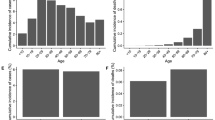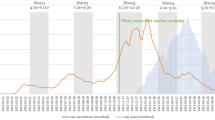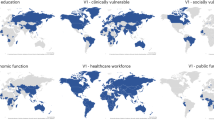Abstract
In this study we exploit not only regional but also age and gender variation in exposure to COVID-19 to investigate its impact on risk tolerance. This study is the first to use age and gender variation in exposure to COVID-19, whereas the identification in previous studies relied on regional variation or simple differencing before and after the pandemic. Using a nationally representative household panel survey in Japan, we find that individuals who were exposed to higher risk of COVID-19, measured by the mortality rate, became more risk-tolerant. The result is in line with findings whereby the experience of standout adverse events and the large resulting losses increase individuals’ risk tolerance. However, the effect appears diminished after the vaccine rollout. An analysis using detailed vaccine records indicates that the vaccination offset the increase in risk tolerance due to the mortality risk, especially for individuals with a higher mortality rate for COVID-19. While the literature on this topic has been inconclusive with a few studies reporting insignificant changes in risk tolerance after the pandemic, our result suggests that granular information on exposure to COVID-19 helps identify its impact.





Similar content being viewed by others
Data availability
All data supporting the findings of this paper are available upon request.
Notes
Tsutsui and Tsutsui-Kimura (2022) provide the only study that uses Japanese data to examine changes “during” the pandemic using the sample period from March to June 2020.
The mean reservation price is somewhat lower after 2016. As we will discuss shortly, respondents to the JHPS-CPS varied over time, with a notable decline in the number of respondents in 2016, and thus changes in the sample may affect the sample mean.
References
Adema, J., Nikolka, T., Poutvaara, P., & Sunde, U. (2022). On the stability of risk preferences: Measurement matters. Economics Letters, 210, 110172.
Akesson, J., Ashworth-Hayes, S., Hahn, R., Metcalfe, R., & Rasooly, I. (2022). Fatalism, beliefs, and behaviors during the COVID-19 Pandemic. Journal of Risk and Uncertainty, 64, 147–190.
Angrisani, M., Cipriani, M., Guarino, A., Kendall, R., & de Zarate Pina, J. O. (2020). Risk preferences at the time of COVID-19: An experiment with professional traders and students. Staff Reports 927, Federal Reserve Bank of New York.
Bu, D., Hanspal, T., Lao, Y., & Liu, Y. (2020). Risk taking during a global crisis: Evidence from Wuhan. CovidEconomics, 5, 106–146.
Cramer, J. S., Hartog, J., Jonker, N., & Van Praag, M. (2002). Low risk aversion encourages the choice for entrepreneurship: An empirical test of a truism. Journal of Economic Behavior and Organization, 48, 29–36.
Drichoutis, A. C., & Nayga, R. M. (2022). On the stability of risk and time preferences amid the COVID-19 pandemic. Experimental Economics, 25, 759–794.
Eckel, C. C., El-Gamal, M. A., & Wilson, R. K. (2009). Risk loving after the storm: A Bayesian-Network study of Hurricane Katrina evacuees. Journal of Economic Behavior & Organization, 69, 110–124.
Eeckhoudt, L., Gollier, C., & Schlesinger, H. (1996). Changes in background risk and risk taking behavior. Econometrica, 64, 683–689.
Ferrer, R., & Klein, W. M. (2015). Risk perceptions and health behavior. Current Opinion in Psychology, 55, 85–89.
Frondel, M., Osberghaus, D., & Sommer, S. (2021). Corona and the stability of personal traits and preferences: Evidence from Germany. Ruhr Economic Papers, No. 903.
Gassmann, X., Malézieux, A., Spiegelman, E., & Tisserand, J.-C. (2022). Preferences after pan(dem)ics: Time and risk in the shadow of COVID-19. Judgement and Decision Making, 17, 745–767.
Gerra, G., Zaimovic, A., Mascetti, G. G., Gardini, S., Zambelli, U., Timpano, M., Raggi, M. A., & Brambilla, F. (2001). Neuroendocrine responses to experimentally-induced psychological stress in healthy humans. Psychoneuroendocrinology, 26, 91–107.
Gollier, C., & Pratt, J. W. (1996). Risk vulnerability and the tempering effect of background risk. Econometrica, 64, 1109–1123.
Goodwin, R., & Allen, P. (2000). Democracy and fatalism in the former Soviet Union. Journal of Applied Social Psychology, 30, 2258–2574.
Graeber, D., Schmidt, U., Schroeder, C., & Seebauer, J. (2020). The effect of a major pandemic on risk preferences—Evidence from exposure to COVID-19. SSRN Working Paper, No. 3724461.
Hanaoka, C., Shigeoka, H., & Watanabe, Y. (2018). Do risk preferences change? Evidence from the Great East Japan earthquake. American Economic Journal: Applied Economics, 10, 298–330.
Harrison, G. W., Hofmeyr, A., Kincaid, H., Monroe, B., Ross, D., Schneider, M., & Swarthout, J. T. (2022). Subjective beliefs and economic preferences during the COVID-19 pandemic. Experimental Economics, 25, 795–823.
Kash, K. M., & Dabney, M. K. (2001). Psychological aspects of cancer screening in high-risk populations. Medical and Pediatric Oncology, 36, 519–524.
Lohmann, P., Gsottbauer, E., You, J., & Kontoleon, A. (2020). Social preferences and economic decision-making in the wake of COVID-19: Experimental evidence from China. SSRN Working Paper, No. 3705264.
Page, L., Savage, D. A., & Torgler, B. (2014). Variation in risk seeking behavior following large losses: A natural experiment. European Economic Review, 71, 121–131.
Quiggin, J. (1982). A theory of anticipated utility. Journal of Economic Behavior and Organization, 3, 323–343.
Quiggin, J. (2003). Background risk in generalized expected utility theory. Economic Theory, 22, 607–611.
Schildberg-Horisch, H. (2018). Are risk preferences stable? Journal of Economic Perspectives, 32, 135–154.
Shachat, J., Walker, M. J., & Wei, L. (2021a). How the onset of the Covid-19 pandemic impacted pro-social behaviour and individual preferences: Experimental evidence from China. Journal of Economic Behavior & Organization, 190, 480–494.
Shachat, J., Walker, M. J., & Wei, L. (2021b). The impact of an epidemic: Experimental evidence on preference stability from Wuhan. AEA Papers and Proceedings, 111, 302–306.
Shapiro, J., & Wu, S. (2011). Fatalism and savings. The Journal of Socio-Economics, 40, 645–651.
Tsutsui, Y., & Tsutsui-Kimura, I. (2022). How does risk preference change under the stress of COVID-19? Evidence from Japan. Journal of Risk and Uncertainty, 64, 191–212.
Zhang, P., & Palma, M. A. (2021). Do risk preferences change during COVID-19? Comparisons between Pre and On-Pandemic Parallel Experiments. SSRN Working Paper, No. 3849536.
Acknowledgements
We would like to thank So Kubota for constructive comments. This research uses micro data obtained from the Preference Parameters Study of Osaka University’s 21st Century COE Program, “Behavioral Macro-Dynamics Based on Surveys and Experiments,” and its Global COE project, “Human Behavior and Socioeconomic Dynamics.” The views expressed in this paper are those of the authors and do not necessarily represent the views of the Ministry of Finance Japan, the IMF, its Executive Board, or IMF management.
Author information
Authors and Affiliations
Corresponding author
Ethics declarations
Conflict of interest
The authors declare that there are no financial or non-financial interests that are directly or indirectly related to the work submitted for publication.
Additional information
Publisher's Note
Springer Nature remains neutral with regard to jurisdictional claims in published maps and institutional affiliations.
Appendix A. Descriptive statistics
Appendix A. Descriptive statistics
Rights and permissions
Springer Nature or its licensor (e.g. a society or other partner) holds exclusive rights to this article under a publishing agreement with the author(s) or other rightsholder(s); author self-archiving of the accepted manuscript version of this article is solely governed by the terms of such publishing agreement and applicable law.
About this article
Cite this article
Mineyama, T., Tokuoka, K. Does the COVID-19 pandemic change individuals’ risk preference?. J Risk Uncertain 68, 163–182 (2024). https://doi.org/10.1007/s11166-024-09427-5
Accepted:
Published:
Issue Date:
DOI: https://doi.org/10.1007/s11166-024-09427-5




